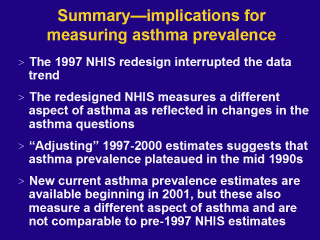| front |1 |2 |3 |4 |5 |6 |7 |8 |9 |10 |11 |12 |13 |14 |15 |16 |17 |18 |19 |20 |21 |review |
 |
The impact of the
1997 NHIS redesign on asthma prevalence estimates is primarily an
interruption of the data trend in 1997. The estimates from the "new" NHIS
are not comparable to the "old" NHIS. Therefore, the data from 1997 onward
must be considered a new trend.
The redesigned NHIS measures a different aspect of asthma as reflected in changes in the asthma questions. The asthma attack prevalence estimates from the redesigned NHIS are lower than the previous asthma period prevalence estimates. Our analysis demonstrated that most of this decrease can be attributed to changes in the asthma questions and that it is unlikely that the underlying asthma prevalence in the population decreased markedly. Beginning in 1997, the data from the redesigned NHIS suggests that asthma prevalence has plateaued since the mid 1990s. A plateau in prevalence has also been matched by plateaus in pediatric asthma hospitalizations and deaths since the mid 1990s (see reference 4). A more intuitive asthma prevalence estimate - current asthma prevalence - is available from the NHIS beginning in 2001. Note that this prevalence is also not comparable to the previous asthma period prevalence from the old NHIS. However, the new estimates allow more insight into the disease burden of asthma. Current asthma prevalence estimates the overall burden of asthma among children, both those with well-controlled symptoms and those with uncontrolled symptoms. Asthma attack prevalence, an estimate of the percent of children who suffered at least one asthma attack in the previous 12 months, is a crude estimate of those children at risk for a poor asthma outcome such as an emergency room visit, hospitalization, or in rare cases, death. Knowing the attack prevalence is important for preventive efforts. While the primary causes of asthma are poorly understood (i.e., it may be difficult to substantially change the current asthma prevalence), the means to prevent asthma symptoms and attacks are well understood. The asthma attack prevalence is a crude indicator of the effectiveness of health care and public health efforts to control asthma symptoms. |